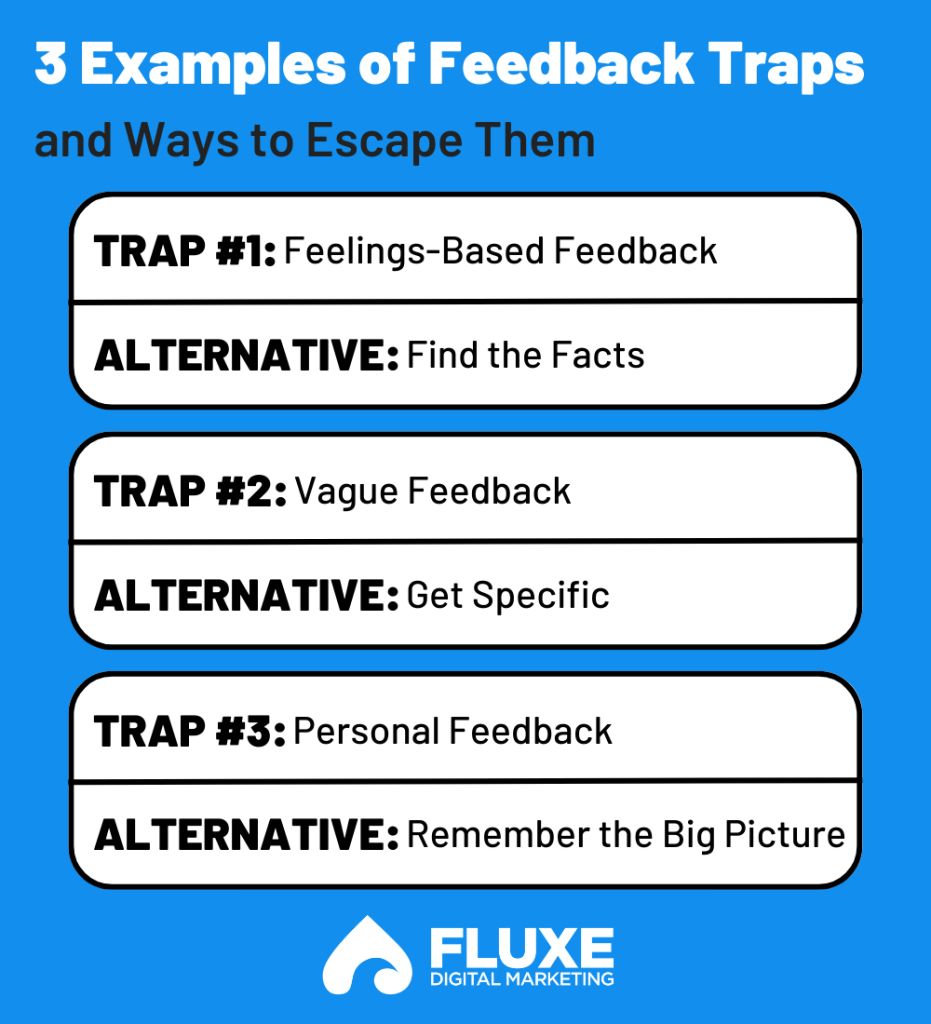Every business needs content.
When a complete stranger Googles your company, you want something to come up other than your personal LinkedIn profile. Why? Because content achieves crucial goals, like:
- Lead generation
- Building your brand and brand authority
- Engaging and keeping existing customers
Whether it be product copy, a blog post, a commercial, or something else, content always serves one or more of the aforementioned purposes. So, when we inevitably have to give feedback to a content creator (more on this in a bit), we need to approach that feedback with the content’s purpose in mind.
Stay cognizant of that, and you’ll get effective, compelling content easier and faster.
Why Do Content Creators Need Feedback?
If you run a business, you need content. If you need content, you need to hire a content creator — either full-time in-house, freelance, or agency. And if you need to hire a content creator, you’ll have to give that creator feedback.
Very few pieces of content turn out perfectly on the first draft. That doesn’t (necessarily) mean your content creator is bad at what they do. It just means the content creator can’t read your mind. (If he can, send me his contact info ASAP.)
You need your content to:
- Represent your brand well
- Accomplish one of the above goals
- Convey a message or information accurately
But on the first draft, a piece may not sound quite like your brand. Or it may miss the mark goal-wise, or get facts or company views wrong.
Thankfully, every great content creator thrives off of feedback — but how do you share your thoughts in a way that moves you toward your marketing goals?
It all comes down to staying aware of common feedback “traps.”

3 Examples of Feedback Traps and Ways to Escape Them
Certain types of feedback become traps because they make you feel like you’re sharing your thoughts constructively, but they don’t actually articulate a way for the content creator to move forward. It’s easy for the most valuable parts of your feedback get stuck in your head — without you realizing the creator can’t interpret your meaning.
Unless you hired a mind-reader (see the note above), you’ll need to provide actionable, constructive feedback to get compelling second drafts that serve your marketing goals. So watch out for these traps:
Trap #1: Feelings-Based Feedback
“I don’t like that” is great if you’re journaling, but your blog is about your audience, not you.
“I don’t like that” is based on your feelings, and nothing else. It doesn’t provide a content creator with anything they can act on. When they iterate, they’re just taking another shot in the dark, and you may not like that, either. It wastes everyone’s time.
Feelings-based feedback overlooks anything specific about the content — it’s just a reaction. Maybe you aren’t used to this form of content, or you aren’t used to another person producing content for you and you’re far outside your comfort zone. Or, maybe there are legitimate problems with a piece, but you haven’t taken the time to identify and articulate what they are.
You’re communicating feelings, not facts.
The Alternative: Find the Facts
The alternative to feelings-based feedback is objective, concrete feedback. Highlight specific words or phrases, and outline why they don’t work. Explain what you’d like to see instead and why:
- “This wording doesn’t fit our brand voice because our brand voice doesn’t include curse words.”
- “The sentence ‘Get yours today!’ doesn’t accomplish the purpose of the content because its purpose is to educate, not sell.”
“Because” is your best friend. If the content creator doesn’t know why you want a specific change made, they’ll have a harder time landing on the right fix — and they’ll likely repeat their mistake in the future.
One little “because” now saves a lot of frustration down the road.
Trap #2: Vague Feedback
Vague feedback is exactly what it sounds like, and just like feelings-based feedback, it leaves the content creator directionless and confused about how to approach the second draft.
Here are a couple common examples:
- “Can you change this?” or “Rewrite” after highlighting a multi-paragraph section or a two-minute clip.
- “This doesn’t sound like us” without identifying reasons why or requesting an action.
- “It doesn’t pop,” or a similarly vague term, especially on visual content. (My graphic designer friends hate this one.)
The Alternative: Get Specific
Be as specific as possible about what isn’t working and what you’d like to see instead.
This doesn’t mean you have to know exactly how you want the content creator to revise their work — that takes away your time and defeats the purpose of having hired a creator in the first place — but you should take the time to point out what you want changed and why.
- “This paragraph uses salesy language. Can you rewrite with a strictly educational approach?”
- “Can you change this piece to third person?”
- “This page reads like a chapter of a textbook. Can you please inject some personality using our brand voice?”
- “This piece has too many calls to action. Can you focus on one?”
Bonus: If you have, or know of, a piece of content that captures the voice you want to use and accomplishes your goal, share it with your content creator to use as a reference. It’ll provide a stronger direction.
Trap #3: Personal Feedback
Remember, your personal brand is separate from your company brand. If a piece of content is produced for your company brand, even if it’s ghostwritten for you, it’ll be written differently than if it were written for your personal blog or YouTube channel.
If you approach a draft thinking, “This should sound exactly like me,” you’ll find a million things you could change. The content creator may use turns of phrase you wouldn’t use in real life, or frame something differently than you would, but as long as the content fulfills its purpose and doesn’t misrepresent you or your company brand, it doesn’t need to be changed.
Personal feedback can sound like:
- “That’s not how I would say it.”
- “I don’t sound like that.”
- Most other feedback that includes the word “I.”
The Alternative: Remember the Big Picture
If you had the time to create your own content, you would. But your time is better spent elsewhere. That’s why you hired a content creator.
Part of delegating is relinquishing a little control, within certain bounds. When you look at a piece of content, don’t ask, “Is that how I would say it?” Instead, ask:
- Does it convey the message accurately and effectively to my audience?
- Does it accomplish the goal of this specific piece of content?
- Does it misrepresent my brand, even if it doesn’t use the exact words I would?
On that last point, the question “Does this represent me?” can easily turn into “Does this represent me perfectly?” That’s why I suggest sticking with “misrepresent” to avoid becoming perfectionist and stymying your content efforts.
No one will ever be able to recreate the exact words or images you see in your head, but with constructive feedback, they can convey the message you want and accomplish the goal you’re after.
Bonus: If you really want to build a good working relationship with your content creator, limit the number of people who review a piece to one person, especially content that’s being ghostwritten for an individual.
When it comes to content, everyone will have a different take and personal opinion. This may sound beneficial, but design by committee almost always results in conflicting feedback for the content producer — and the end product is a watered-down version contributing far less impact than it should.
Remember, a human being’s point of view is far more valuable than a committee’s point of view.

A Few Additional Tips…
While giving feedback, you don’t have to limit your focus to the negative. Reinforce what you like with positive, encouraging language:
- “This sentence does a great job of educating rather than selling. Well done.”
- “This graphic uses our brand colors to grab attention and highlight the call to action really well.”
- “This blog post is full of personality without going outside the bounds of our brand voice. Great job!”
Positive feedback does more than just pump up a content creator’s ego; it gives them insight about what you like, what represents your brand well, and what accomplishes your goals. They can then take that information and apply it to future work.
Remember, giving as much feedback as you can now prevents you from having to give it later, saving both you and your content creator time in the long run — and that’s something everyone can appreciate.



